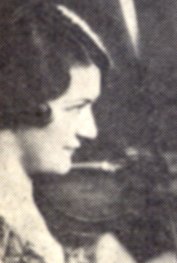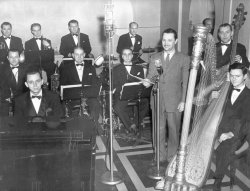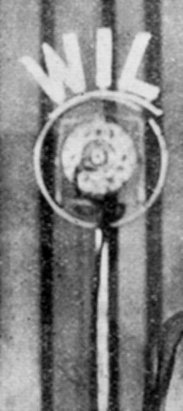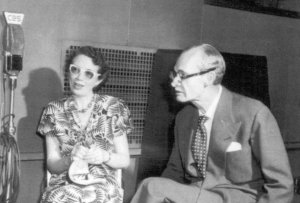Radio Articles
She Directs the Programs on KMOX
(Unsigned article)
Katherine McIntyre’s desire for the original and something different, together with her unusual qualities as a violinist and business woman, have been responsible for her steady rise to the eminent position she now holds in the field of radio broadcasting – Program Director of Radio Station KMOX, the Voice of St. Louis.
Miss McIntyre has had wide and varied experiences in the musical world. She has been concert violinist, accompanist, teacher, staff violinist, studio director, program director and has appeared on the concert stage and in vaudeville in almost all of the large cities in the United States, Canada, Mexico, Italy, France and Austria, and thru her untiring efforts, musical ability and a desire to achieve something, she has earned the difficult and exceedingly responsible position as Program Director of one of the largest and most powerful radio stations in America – KMOX.

Not only is Miss McIntyre gifted with musical talents bordering on the genius but she also has the unusual qualifications of an executive and business woman. It is seldom indeed that these two qualities are found in one individual but leave it to Miss McIntyre to be different. Yes, it’s her innate desire for the original that has been the contributing factor in her rise from “just another fiddler” to the executive in charge of all programs originating from the KMOX studios.
Another characteristic which has been a great aid to the success of this unusual personage is her mild easy personality which instantly wins respect from even the most casual acquaintance. One just needs but to step into her office, engage her in conversation for a few moments to feel the effects of her winning personality, which fairly breathes of sincerity, truthfulness and understanding. There is no need for sternness in the exercising of her many duties for Miss McIntyre is so sincere and understanding that the element of force is unnecessary.
Miss McIntyre began the study of music at the age of five years at the old Horner Institute of Music in Kansas City, Missouri, where she attracted so much attention that at the age of 16 she was taken on a concert tour which lasted for about five years, in which time she visited every state in the union and played in most of the large cities of the United States, Canada, and Mexico.
Concert work became tiring for Miss McIntyre, it had lost its originality and appeal. So after her last concert tour she entered the field of vaudeville making the country on the old Kieth Circuit as a headliner. Soon too this new field lost its glamour and glitter for it bordered on the monotonous. Where then was something original? What new field could she enter? Radio then was in its infancy and did not hold the possibilities for immediate advancement. Europe was the place to go. There would be something different in the way of music. She would go abroad to study and to exercise her musical talents. So this restless lady sailed to Europe and studied in Paris, Florenz and Vienna under such noted masters as Mario d’Ancona and Kreily. Miss McIntyre stayed in Europe for over two years studying and making personal appearances in the larger cities of the old continent. Soon too this became dull and too, radio began to develop and to offer possibilities. So one day in Vienna she heard that KMOX was to be organized, right then and there came to the decision to enter the field of radio broadcasting. Quickly she sailed for home and came to St. Louis to become a staff violinist of KMOX.
Her career as a staff artist was short-lived for the managers of KMOX saw in this lady possibilities that were more valuable to them than her musical talents. Yes, violinists could be had at almost any time, perhaps not as skilled and talented as Katherine, but they could answer the purpose anyway. So Katherine was made Studio Director, a position of responsibility which required real executive ability. It was she who would see to it that all programs were broadcast at [their] scheduled time and it was she who would see to it that all artists were at the studio in time for their programs. These duties took almost all of her time but she saw improvements that could be made in various programs. She visualized new programs that could be created, so in her spare time which by the way was very spare, she tried her hand in originating new and novel programs to break the monotony in the day’s radio schedule. She was so successful in this line that she later was given this creative task along with her other duties.
Miss McIntyre did not mind this extra work, she loved it even if she had to work all hours of the night, then be back to the studios early the next morning, because it gave her the opportunity to do something different, to create new programs and new ideas.
Soon came the “break” that gave Katherine her big opportunity. George Junkin, who was then program director of KMOX resigned and went to his home back East. Katherine was the logical person to succeed him and she was instantly appointed as Program Director, a position she has since held.
Under her direction many new and highly entertaining programs have been created, both local and national. It is she who is responsible for the musical portion of the “Voice of St. Louis Program” which is broadcast for a full hour every Sunday morning at 10:30 over the coast-to-coast network of the Columbia Broadcasting System.
(Originally published in Radio and Entertainment, 10/24/31)


